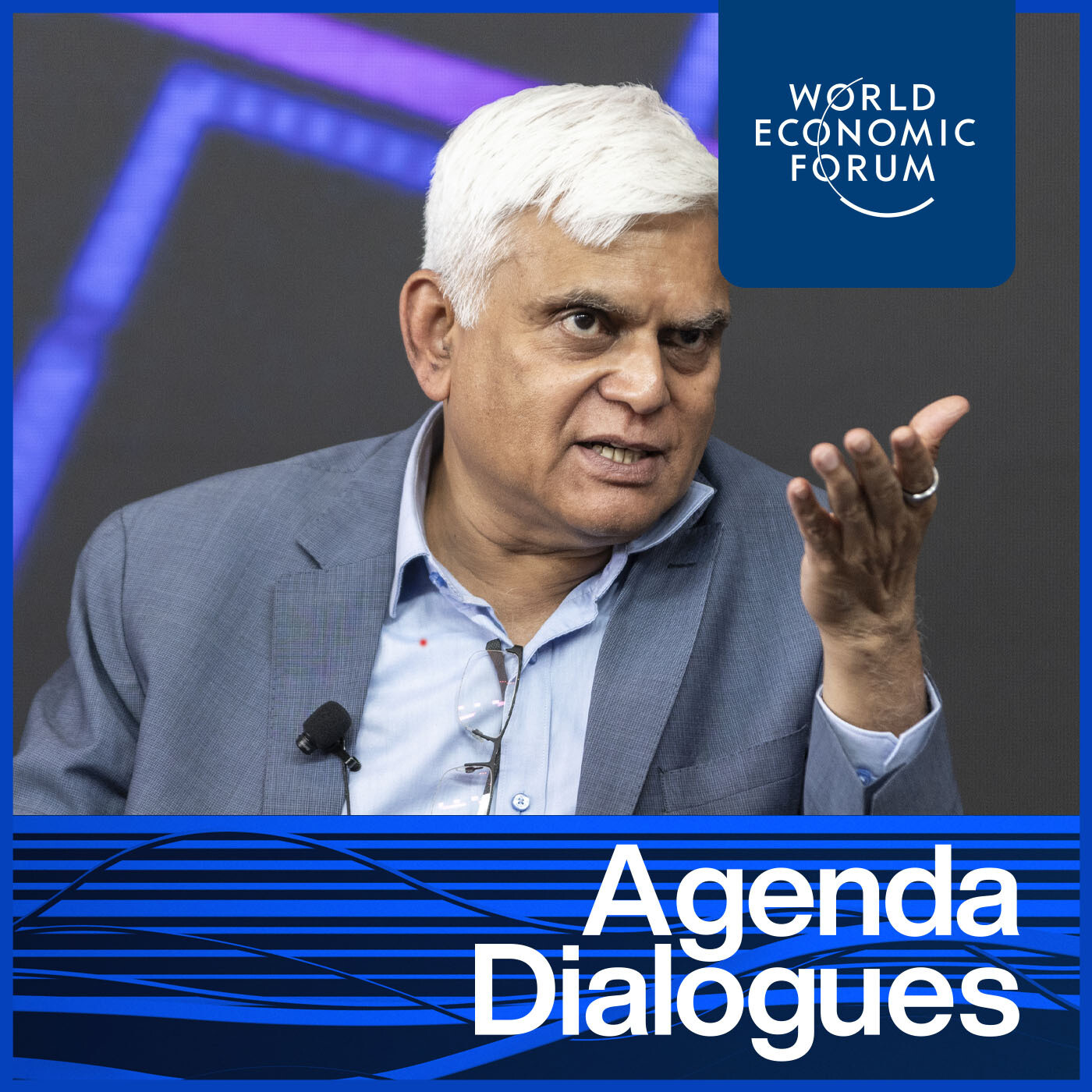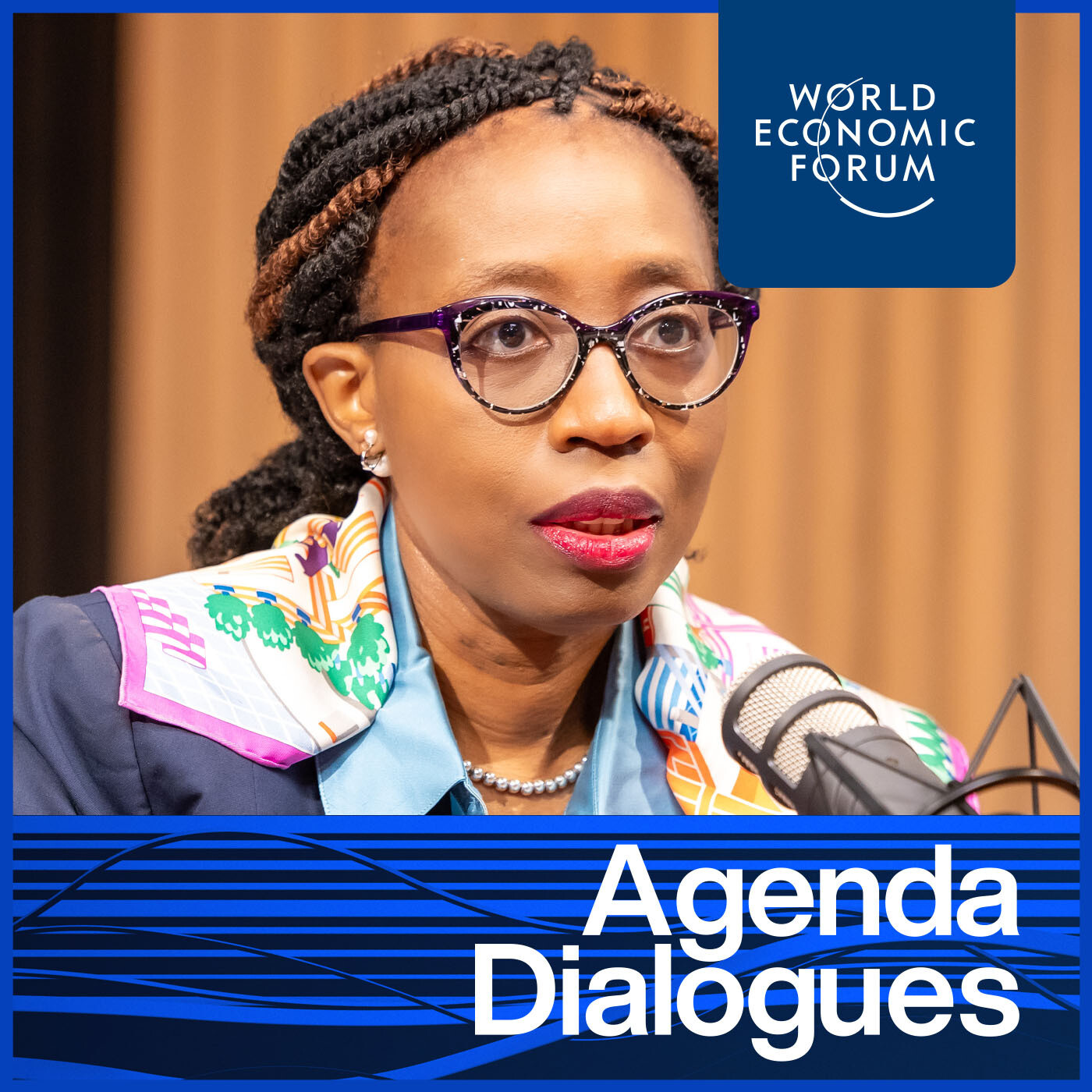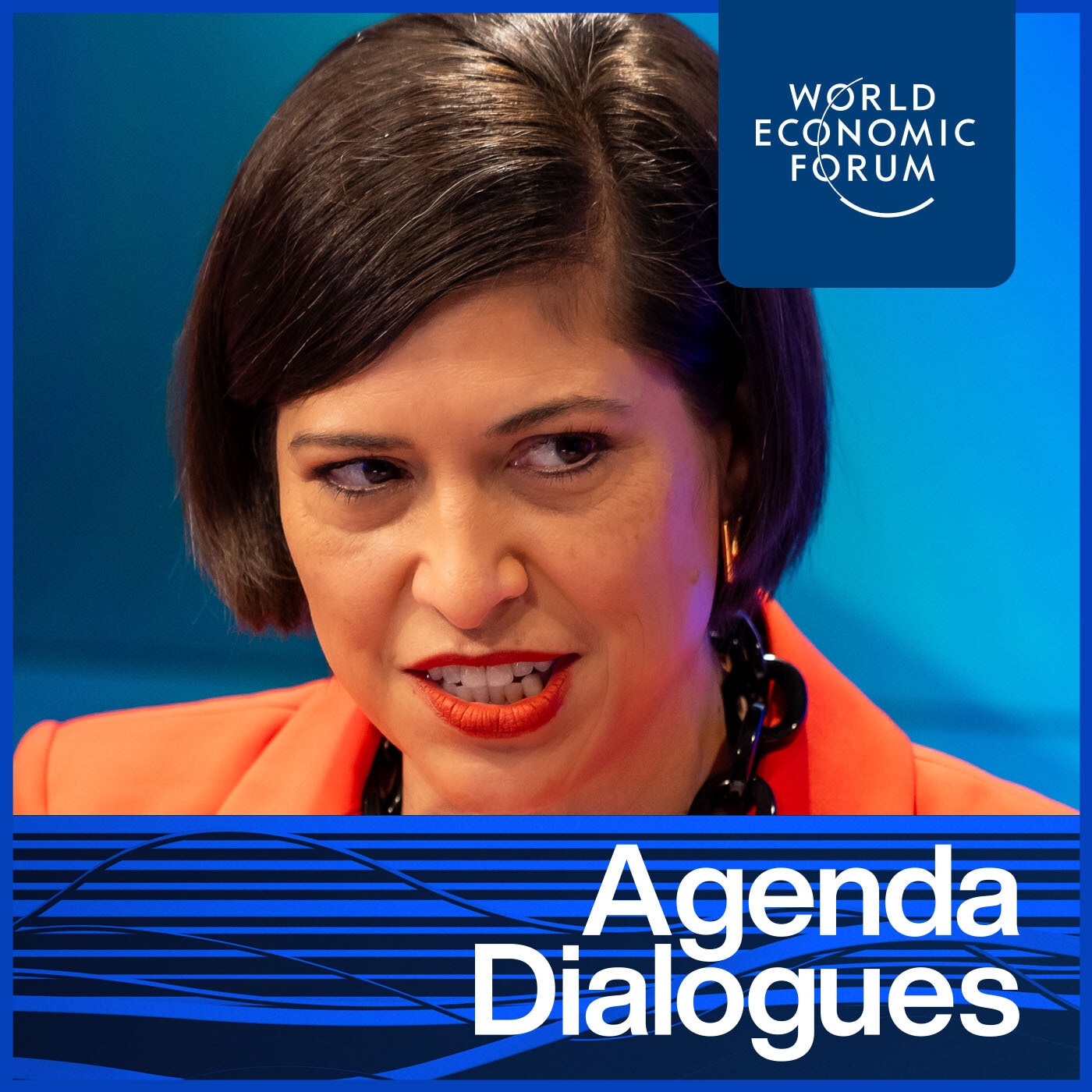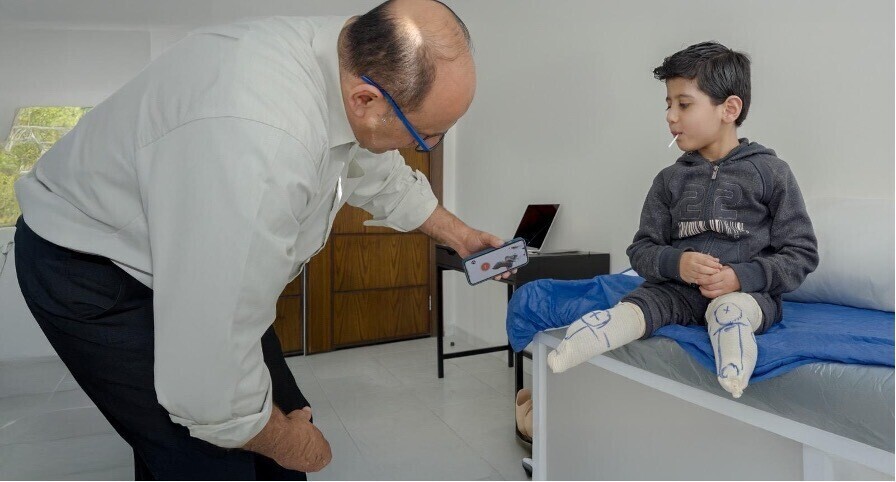AMGFC24: The Nexus of Innovation
ポッドキャスト・トランスクリプト
This transcript has been generated using speech recognition software and may contain errors. Please check its accuracy against the audio.
Azeem Azhar: This stakeholder dialogue is part of the World Economic Forum's Annual Meeting of the Global Futures Council here in Dubai.
Our topic today is "The Nexus of Innovation." I am Azeem Azhar, I'm the founder and CEO of Exponential. I'm an early stage technology investor and a few years ago, I wrote a book on technology convergence and the acceleration of technologies.
So, I'm delighted to be the moderator of this panel today. As His Excellency spoke about that yesterday, as the fourth industrial revolution advances into the exponential age, we find ourselves at a period where technologies, both foundational and applied, are converging.
This convergence creates opportunities. It makes new breakthroughs happen. It may accelerate innovation across various fields and these technologies may combine and these novel combinations may yield new technologies.
Consider the electric car. It brings together batteries, motors, new materials, new sensors, semiconductors, chips, artificial intelligence. Or consider that during COVID, the vaccine maker BioNtech acquired InstaDeep, an artificial intelligence company.
InstaDeep had the ability to use AI to provide early warning for the emergence of new COVID variants and this allowed BioNtech to prepare vaccine candidates ahead of formal identification by the World Health Organization. This was a combination of AI and biotech which enabled timely and delivery of these important immunotherapies.
Now, my first book, The Exponential Age, covered this idea of combinatorial innovation as one of the accelerators in the improvement of technology, the decline in their price.
It touched on the ecological nature of technologies, how they contribute to each other, how they shape requirements, how they expand use cases and how they send signals to scientists and engineers and signals to the market. But have we reached a new intensity or level of technological convergence?
What's that relationship between scientific research, academia, innovation and what role could the public sector play at the different stages of the life cycle of these technologies?
Are there strategies that we could use to actively take advantage of technological convergence. So important questions and to discuss this, we are, I'm delighted that we've got an expert panel with us today.
We have Chantal Shen, who is the chief scientist at the Synthetic Biology Unit at BGI research in China. We have Freeke Heijman, who is the founder and CEO of Heijman Consultancy advising startups and governments, corporates on innovation with a strong, deep background in quantum technologies.
And we have Hoda Al Khzaimi, who is a director for emerging technology acceleration and research at the New York University Abu Dhabi and she's prototyping the evaluation of emerging technologies. Hoda actually has many other strings to her bow. She's an example of technological convergence sitting in front of us.
Let's start with this discussion. I think that artificial intelligence is perhaps the central hub that could accelerate convergence. That was in my setup, in my introductory remarks, is that correct is the most important force? Have I got it wrong? Are there other forces, perhaps Chantal, I'd start with you.
Chantal Shen: Okay, maybe I will start by introducing the definition of synthetic biology. So synthetic biology combines the biology, computer science and engineering, trying to engineer and create a organism that can function specifically and you can think it as a way like we can programme living organism to function in a specific scenario for us.
So, like food, healthcare and also energy. So I think for your question, how AI will further facilitate the development of synthetic biology is with all this digital technology advancement, like for for example, GenAI, we can actually accumulate a lot of data.
But then for AI, it can actually accelerate with using or handling this big data, for us to predict the response of how we design the organism and how it will respond in function to further improve the efficiency for us to R&D. So I think that is example for my part.
Azeem Azhar: Thank you. AI is flavour of the moment, in some sense. But is it the only lens we should use when we're looking at technological convergence? Freeke.
Freeke Heijman: It is a very important lens. I think everybody knows the way AI accelerates, for instance, the identifications of new materials, the defining of, for instance, new batteries or materials for batteries, for the energy transition, it advances from years to days using AI technologies.
But it's not the only lens because I think the interesting part of the convergence is the interaction between those technologies. For instance, quantum technologies and quantum algorithms can, on its turn, enhance machine learning algorithms from AI.
So, for instance, Crédit Agricole, which is a French bank, they just announced that Pasqal, which is a European quantum computing company, they provided tools, quantum algorithmic tools that improve their learning algorithms, for their neural networks, for the forecasting of financial systems.
So there's interaction between all those aspects and with biology, the identification of how medicine play out in human cells or in the human bodies. There are already quantum algorithms being used that are run on classical computers that have a better performance than if you would use classical algorithms.
So you see the interaction between those emerging technologies accelerating with indeed AI that is going so fast at the moment.
Azeem Azhar: So we've already heard in the first two responses some really breakthrough cutting edge technologies – from synthetic biology and external generation sequencing, quantum computing, quantum algorithms, quantum algorithms on classical computing.
To somebody who perhaps is not in the technology industry, this could sound like a shopping list – a list of wonderful things we want to buy.
How is it more than a list of things we want to buy? How are the interactions between them occurring and how are they relevant?
Hoda Al Khzaimi: Great question Azeem. I would say it depends on the ecosystem who's analyzing the value chain of what we're developing across converging technologies or converging industries in general.
I think the first example you gave is a pure example of how when we develop for one single technology, we have to care about the ecosystem impact and the cluster impact. Certain economies are aware of this.
So when you develop, for example, biosynthesis technologies, or they call them, right now, the new tech organisms.
Azeem Azhar: Could you say what those are? In a word or two.
Hoda Al Khzaimi: One hundred percent. You're today trying to mimic bio or kind of synthetic organisms and use them for computational advantage.
I'll give you an example that we work on in the lab at the moment is, how can we generate true randomness out of the bio cells and mimic the true randomness that's coming in the bio cells?
Because most of the randomness we use in our devices' computational infrastructure could be pseudo randomness structures that would allow you, in the future, to break into the systems or degrade, I would say, the level of computations that exist and because of the sources of energy provided to those computational devices, we are at a bottleneck.
We cannot push for a natural like randomness because of this.
So this is what we call true randomness structures, the bio cells or the bio kind of organisms they have that are already engineered within biosynthesis, we are trying to just mimic the randomness in order to use that for computational infrastructure by passing the overhead of computation and by passing the overhead of energy consumption on these devices.
Imagine holding your phone and rather than having a pseudo random number device generating randomness required for your computation, your body is actually, is your pseudo random number generator that could be sensed.
So this is one example and many example that exists that could revolutionalize the end product that we have today.
So going back to your landing question here, how can we build an appetite for conversions through understanding that it's not about the certain technologies that that are available in the short term, rather than following the uncertain pathways of new disruption that might exist in the future.
And we have, historically, many examples that support that. For example, look at the current conversion that happened on protein kind of discovery and genome, protein genomes discovery and AI kind of convergence.
If you asked the researchers who are doing this type of research three years ago. How? How close are we from doing this kind of total protein mapping globally?
They will tell you, maybe within 15 years or 20 years, we will be able to accomplish this, especially in a pharmaceutical industry, where the innovation platform within this is pushing you towards patent structure, or innovation structure that is 15 years into the making, or 30 years into the making.
But the AI disruption contributed to acceleration of discovery here, bringing this mapping sooner to market. So those type of conglomerate effect is very important for us to analyze.
Azeem Azhar: I think that's a great example. The example you just came up with, which was about the use of AI in protein discovery.
So last week, the Nobel Prize for Chemistry did not go to chemists. It went to three – well, one was a chemist who worked in computers but the other two were AI researchers, including Dennis has who is the founder of DeepMind, and I think that speaks a lot to what happens when domains intersect and interact.
You brought this expertise from computing, from the domain of artificial intelligence, of course, that somewhat sits more in your domain, Chantal, in some sense.
And I'm curious about how, within your domain of synthetic biology, you people look at themselves. Do they see themselves as biologists? Do they feel them themselves to be limited if they are just biologists? I mean, what do these look like? And how do people conceive of their roles?
Chantal Shen: I will say in our field, we always describe ourselves as a biologist but with an engineering mind.
So we always think about standardization, robustness, something like that to consider, because biology is such a complex system and there are so many, you know, like genes within the cell, that they function in a coordination way.
So you can, you know from the cell the phenotype, the behaviour they changes in response to the environment and some kind of simulation. So, yeah, from our end, is synthetic biology is really a real practice for convergency in our field.
We have computer science, we have physics, we have engineering, we have biology and also other disciplines working together to solve a complex question in a way covers so many different discipline.
So there's one time my personal experience. I found this really interesting, because I was trained as a bio engineering background. But then during one of my founding interview and one of the person asked me, you are biologist but how come you can develop equipment?
And I say, OK, I didn't know that before but when I really practice and DNA synthesis is one of the bottleneck, I start to work across different disciplines and together with my colleague, helped me to understand how to solve the problem from a different way. So yeah, that's the real question.
Azeem Azhar: But your field strikes me as a field which, in the academic space, by necessity, has to have convergence. It has to cut across the silos that we see in academia. And I'm curious if we spent a second to ask that question, because this does start with research.
What can we learn about breaking the silos? For me, it was no real surprise that computer scientists won this Nobel Prize in essentially biochemistry, because they were able to cut across traditional structures. But are there things that we can learn? Perhaps you have a view.
Freeke Heijman: I think there's much to say about this. For instance, in the computer science field, we see quantum computing that may be a threat to our classical cryptography key. So that brings together the classical ICT cyber security sector with quantum physics and post quantum cryptography.
And you see these are two communities that come from a different background, have different trainings and it takes time to get them to talk to each other and to understand each other. And I think that's the essence of convergence of technology.
Biology is such a complex field, synthetic biology, physics as well computer science, AI and you need to train people who can form the bridge and who can become multi disciplinary. And it's in the scientific part but it's also regulatory and policy makers and institutional bodies that we have to govern these sectors. They need to be, yeah, integrated.
Azeem Azhar: So coming to that question of getting these different disciplines to work together, which seems to be important. It's working in Chantal's domain as explained.
Its importance from your perspective, you have a lateral, horizontal view of technologies. What are the specific things that you are doing to encourage researchers and academics from different domains to be able to collaborate in some of the ways that we've discussed here?
Hoda Al Khzaimi: I think one of the most important aspects is removing the barriers of collaboration and focusing to providing what you call psychological safety for everybody coming from different fields, to put their ideation process forward and execution process of these ideas forwards.
You are trying to build that kind of paradigm of support in real time in terms of investments, in terms of building the new innovation structures around a specific industry or technology in order to empower the researchers.
So if I have someone telling me, what if try to do this, which kind of can be considered like a sci fi prospect of building a new innovation, can I do it? Because normally, we are trying to build a specialist within fields that have, you know, a depth of knowledge. But when it comes to you know, motivating cross sectionality of impact across these fields, we don't do enough of credit of the subsidiary work that happens.
So, for example, even in our maps, I feel what you just said, we have a lot of subsidiary advantages that gets, I would say, fabricated. We fabricate chips and we do a lot of work around the new models and a new equipment and to the point that we are doing as well work around the new sources of energy that would support us to develop a new hardware, because we need it for the parts that we're developing on the higher layer.
And people who are working on that level of discipline are not yet at that perception level, because they are trying to solve a problem from a specific perspective. So removing these barriers across sector is very important.
And I think empowering them with resources to do that in terms, I would think funding interdisciplinary kind of action on multiple layers and research layers and the commercialization layer and as well into the market access layer is very important.
Azeem Azhar: Just a very brief follow up on that, because we've heard that to get through the silos you have to have specialists who can talk to each other. They need to have psychological safety. Presumably, they also need to have technology systems that talk, talk, the same data to each other.
But at the top of that, you need to have people who are able to guide that process. Or is it a bottom up process that happens from the interactions of these specialists?
In other words, who's doing the designing and setting the vision, and what are the characteristics of that person? And maybe just a quick response from you on that.
Hoda Al Khzaimi: It's a mindset game. We need to bring in specialists to be generalists and thinking if they want to govern and nurture a project of that kind of overarching, horizontal nature, they cannot cancel, I think, the impact of people coming across nations.
So it's a mind across the different value chain. So it's a mindset process of encouraging generalists to be part of the conversation without diluting the value of speciality that's building for this technology.
Azeem Azhar: Freeke, I'd love your perspective on that briefly.
Freeke Heijman: Well, I think it's a combination of people with certain skills but I also think it's a way of organizing the work. So moonshot projects, for instance, we had a workshop here in Dubai, on convergence. And this was an idea that came out that for certain challenges that we face, for instance, energy transition and also the increase of energy consumption of AI systems.
You can debate on the severeness of this problem but at least you can sort of set moonshot challenges or come up with solutions for this. And this is computer science with material science, with all kinds of combination of so I think that could be an idea as well.
And one thing also, from a personal perspective, I also think AI, on its own can accelerate these boundaries that we need to sort of break down because, for instance, language in our country.
In the language you have people who don't speak Dutch, who don't speak English but you do have to communicate. I mean, that would not have been possible 10 years ago, and now you take your app and you just speak your own language and the person listens and it works, you can communicate.
And thinking that further ahead, maybe also, if I have to speak to a biologist, which I cannot understand, AI systems may help translate.
Azeem Azhar: They can absolutely translate from biology to ordinary language. So a piece of homework for anybody watching here or at home is to go to one of the large language models and because they have knowledge across every scientific domain by their own nature, they have broken the silos.
So you can, as I sometimes do, go in and say, Well, what have immunologists discovered about networks in the immune system that could be relevant in the design of new electrical systems or in the design of computer networks? And you can cross across domains in a way that was very difficult previously.
Once we have these great innovations, the scientists have worked together in the safe environment, with some vision, we need to get them into the market and sometimes particularly with biological products. That is a regulated market that is structured in a particular way.
I'm curious Chantal about the type of work that you and your colleagues do, is the framework in which your innovations need to be put into the market sufficient for the types of innovation you come up with?
Chantal Shen: I'll try to understand the question by so for synthetic biology, we also trying to do the proof of concept in the lab. Trying, for example, we building is the genome from scratch and trying to prove, okay, now we can truly build it so we truly understand the organism we are doing.
Azeem Azhar: So I'm going to interrupt you because this is an amazing story. You told me yesterday that you have taken the genome of the yeast, a full microorganism and you've reconstructed it from DNA bases that you have built yourself, like Lego bricks.
Chantal Shen: Our consortium together, building the entire genome from scratch. Yeah, but I actually want to, meanwhile, we also trying to explore how we can actually using the synthetic yeast for downstream application.
So we kind of like doing a lot of different experiments in the lab, saying, OK, we can actually improve the robustness in extreme conditions, so it potentially can go into bio manufacturing applications.
But then in the real case, actually, we realized, whatever done in the lab, it just single, one step before it's the real application. There's a lot more.
For example, for the bio manufacturing process, you have this infrastructure improvement so you can cope to the new designed scenario. And also there are other operation, and also a lot of improvements are needed from the downstream application, downstream industry.
So I think in the long run is for the innovation, the best is the industry related. The industry also can get access to the early stage R&D as soon as possible. So actually, they can really engage in the whole process to make sure that the thing can really goes through the application more smoothly.
Azeem Azhar: Yeah. Right. So that is, sounds like it's kind of communicating across the value chain. We often would do that simply through market signals and the occasional trade show. You're suggesting it needs to be perhaps more sophisticated a mechanism than that. Hoda, did you want to add to that?
Hoda Al Khzaimi: I think we need to re-engineer the system to fit for the purpose that we are developing for converging kind of industries and technologies, because the current model might stifle the conversion cycle or might de-accelerate the conversion cycle.
So we have to think of how can we provide not just a great innovation, inception, research, inception, scientific kind of progress on prototyping but make sure that we take that prototype to accelerate commercialization, accelerate technology readiness, and then a faster market access to the point that we also get into the financials market future risks and future as well the risking factors.
Most of the work that we do on hardware, I think, in biosynthesis and the work that we do on hardware development requires a lot of disruption on the silicon level and not just on the silicon level and the way we apply what minerals should we use.
Because the nature of the minerals will impact the subsidiary functionality that you can build on the hardware. So being able to go to up to that granular level in order to change it, because you want to build a faster compute organism that you can build and bring to market faster is great, because that's how the moonshots, that free kick just discussed, can be achieved.
Because we can't just build the future moonshots of moonshot conversion based on the current model. It's, I think the current model is not fit to that purpose, especially the funding aspects. We talked earlier about the funding aspects. At the moment, there is a VC structure that funds those amazing ventures, or startups.
I don't like calling them startups but ventures is a proper term because you support the full cycle of development of a technology. They're meant to fund you on the basis of short term progress. And to support this level of innovation, you need to understand the whole cycle value, bring it to market as fast as possible and give it as much of investment as possible.
So that's what we call permanent capital investment. So if I want to invest in something that Chantal is developing in her lab, where we can do is make sure that she is safe for the next 10 years in order to bring this to market as fast as possible and whatever she's bringing to market is as well safe in terms of sales and distribution for the next, I don't know, another long term period of time.
Azeem Azhar: think that you've identified one of the great misunderstandings about innovation, let alone convergent innovation, which is that it's a very long term game.
I'm involved in a nanotech company where the initial research started with the supervisor of the PhD supervisor of the PhD supervisor of the person who's the CEO of the company back in the mid 90s and you need 20 years of funding.
Most venture capital funds are a 10 year plus two or three year extension and therefore, your focus on permanent capital in order to do that, the one stakeholder perhaps we haven't brought into the room yet is the public sector and what regulation or policy or incentives could do to help this field.
So I'll come to you with that, Freeke. But one public announcement separately is, I'm going to be looking for questions in a couple of minutes and there are mic runners who will come around, so pop your hand up if you have a question.
So coming back to Freeke, what is the role of the public sector or policy to facilitate or accelerate or catalyze conversion innovation?
Freeke Heijman: Yeah, well, I think what Huda said about the investment that's very important. So to make sure that there's sufficient capital in the market to fund these long term projects can also be with guarantees coming from government, making banks and other capital providers able to provide this capital.
But another thing is very important. I think it's the governance and the governance risks, because, well, we see with AI, it has immense opportunities but it also has certain risks.
If you see the hallucinations and that goes for these converging technologies, if it's there. I mean, the synthetic bio there is some risks attached to it and if all this accelerates each other, we have to make sure that the public sector is aware of those risks and implements necessary measures to mitigate these risks.
Also in the quantum space, in 10 years time, the risk that quantum computers can crack RSA codes is 30% so governments need to get ready now and also to inform the public about it and to bring them along on this journey that we're also excited about.
It's very important because if there is a new technology but nobody wants to use it because they don't trust it, then you have nothing. And I think in the end, you cannot leave that to the tech entrepreneurs or the operations that want to make money only so that would be my big call for action for government.
Azeem Azhar: Yeah. I mean, there's a great example of the challenge of public trust. Genetically modified foods in Europe have a very poor, poor reputation. With nuclear power has a very mixed reputation in some parts of Europe, once again.
But you talked about the important role of of government, with risk and with maintaining public trust, or fostering public trust. But are there any other active policy measures you think that might be relevant towards, perhaps how you catalyze investment, or the way in which groups can work together?
Freeke Heijman: Well, I think in Europe, I know most about the European ecosystem, there's a big problem with deep tech, long term funds for startups and scale ups. So we're unleashing pension funds now to also have them flowing money into debt.
So that's a topic, and also there, it's important to come up with these topics that are multidisciplinary, so not to only have funds focusing on this, or semiconductors or photonics but to really create the means that also makes it possible for interdisciplinary solutions that may not be clear cut.
It may be a journey that is not clear what the ideas that will come out of it.
Azeem Azhar: Fantastic. I'm now going to turn to the public on the subject. Do we have any questions at this point? Please pop up your hand over here. There'll be a mic coming to you.
Audience member 1: I'm a professor at Howard University. I'm just curious about the state of quantum computing and obviously has made a tremendous rise in the last two or three decades – photonic, topological, superconductor.
I'm just curious, when do you think the ChatGPT movement, if you will, will come in the quantum computing and what will be the catalyst to make that happen?
Freeke Heijman: Yeah, that's sort of the $1 billion question for everyone, I think. I'm not sure it's going to be one ChatGPT moment. There are already several moments with interesting applications. Quantum sensors already have applications in the defense domain.
There's already some quantum algorithms helping out classical machine learning algorithms. There's more and more quantum systems getting to a certain maturity level. So I don't have the glass ball so to say, so we're all waiting for that moment.
And I think there will be a time when we say, OK, now we look back and we think that was the moment. Is it going to be 10 years, five years, two years. I'm optimistic because I'm in the field for 10 years now and I have to say, all the expectations are met faster.
So if you see the speed of discovery and speed of improvements of several platforms, ion trap, superconducting. I mean, it's very, all very promising. Some setbacks. Topological computing, it's well, long term.
Azeem Azhar: I mean, of course, the answer on quantum computing had a lot of uncertainty about it, as to be expected. If we come back to ChatGPT moments, though, that would be interesting in the biological domain Chantal?
Would you say synthetic biology has had its ChatGPT moment? If it is, what was it and if it isn't, where do you think it would be and what would that moment look like?
Chantal Shen: I think that in the past few years there are few, turning point for synthetic biology is when the first production of the anti malaria drug, the anti methylene produced by the engineered yeast.
So at that moment, it is certainly serving as a turning point. So people get to know about what's the potential for synthetic biology, but I kind of like getting the feeling like, in the future, the certain turning point is no longer a simple technical breakthrough but more like combining AI, other technology together.
Synbio can actually come solve a complex issue in a holistic way. So I think my answer is little bit like general, but this is how I feel.
Azeem Azhar: Thank you. Let's take another question. Yes, there's a lady behind.
Audience member 2: Thank you so much for these interesting reflections and information. My question is, goes to Freeke on the ethical considerations.
I think is a very important point and because now we do have some ethical considerations in different disciplines but now we have to come to a converged concept of ethics and of risk assessment in these topics, which is not the same, because we have emergence, not only technologies but also emergent ethical challenges.
Can you say anything about that? I mean, I think this is a very, important point.
Azeem Azhar: Freeke. If you take that briefly, then we'll come to Hoda as well.
Freeke Heijman: Yeah. So very happy to hear your thoughts on it.
I think it comes all, it boils down to bringing people together, because ethics in bio, it's expertise on its own and the same goes for AI quantum, more the computing space.
So bring these people together and give them an assignment to come up with governing principles or ethical principles to develop these emergent technologies.
Hoda Al Khzaimi: Definitely and I think when we consider the risk map, there is a report that we just produced yesterday with the GFC of cybersecurity, focusing on how do we frame the risk map when we are considering emerging and critical technologies and now as well converging technologies coming into the map because they have a subjective terminologies in terms of definition and impact.
And I think the one takeaway that we need to focus on, it's not just a singular mapping towards ethics or towards policies and regulation. It's supposed to be a holistic analysis that allows for innovation to happen and allows as well for different mitigation mechanism to exist, to de risk automatically or systematically, any kind of concern that would arise on different levels.
We have categorized the levels into a national level, an organizational level and individual level, because most of these technologies that would come to disrupt societal kind of innovation or societal kind of way of thinking and performing would be a public concern.
So ethics are massively our public concern, first and foremost, and then everybody else follow the government, the organization and every stream of technology.
So our number one kind of recommendation is to make sure that the group of scientists who are coming from interdisciplinary map is actually thinking of ethics and inception.
And as well, when they're developing it, they're developing it with ethical kind of consideration and inception, allowing that kind of a free process of innovation to exist but also at a consideration of something that we call resiliency by design and not just putting something to market that or in the hands of the public that does not qualify as a generic purpose or tool of impact for the public.
Azeem Azhar: Do you have to deal with these questions within your work as well?
Chantal Shen: I mean, for synthetic biology, for scientists and also in the community, we always have this in mind. Is having the ethical considerations when we during doing the practice in one of the example that I would like to share is for the genome constructed gene a genome synthesis process.
Actually, this year, in April, we published an ISO standard that clearly described that for biosafety and biosecurity purpose, the DNA sync sequence need to be screened before we synthesize them to avoid, you know, like hazard, you know, potential, like problems. So, yeah, this there are ongoing efforts.
Azeem Azhar: Thank you. We have time for one more question. If we have one more question from the group, I can't quite see behind me, someone needs to engineer me eyes in my head. Oh, there's one there. Great. Thank you.
Audience member 3: My name is Florence. I work for the Defense College. I have a generalist question, what do you think are three characteristics of the innovators mindset that you can pass on to other people like myself?
Azeem Azhar: Three characteristics, each for one. So we do that. Perhaps we'll start with Freeke and come to Hoda and finish with Chantal.
Freeke Heijman: I think not knowing the outcome. So to go investigate or go on a path, explore, be an entrepreneur, and not exactly knowing. You have a goal, you have a mission but you don't know. And if you like that, if you like the unknown, I think you're an innovator.
Azeem Azhar: So that sense of curiosity and where will it take me? And I'm not too worried. Wonderful anwer. How about you?
Hoda Al Khzaimi: I think high sensitivity of self regulation, or when to go and full speed into a specific domain and when to jump across barriers and integrate resources to make things work down the line, because it's actually a survival, long term goal and for you have to be resourceful.
Think beyond the box and the paradigm that you have and integrate different ecosystems.
Azeem Azhar: Thank you. And Chantal.
Chantal Shen: Be open minded and embrace collaboration.
Azeem Azhar: What's the benefit of the collaboration? Just to expand on that.
Chantal Shen: Keeps me learning.
Azeem Azhar: Keeps you learning. Thank you. That's fantastic.
Let's try to summarize some of the things that we've covered off in today's panel, The Nexus of Innovation, which we looked at the process of technological convergence, we tried to understand what it was, why it's happening and why it benefits us.
Some of the things that I picked up was that combining the technologies creates new applications, new products but it also creates new technologies, which in themselves, can be combined for future technologies as an ecological aspect of that artificial intelligence has an important role as an accelerator but also as a tool of exploration.
That quantum remains important, but still somewhat uncertain, like the cat in Schrödinger's box, there is a role for the public sector, an important role in ensuring that risks are managed, understood and communicated and also a really critical role in building public trust widely.
One thing that we should recognize is that levels of trust in technology are relatively high in some parts of the world and very low in other parts of the world. It's not an even picture globally. The question of funding came up at the time and again, I think, in a number of different ways.
During the life cycle of these technologies and their development, different classes of funds are required with different risk profiles from challenge prizes was raised. But also the other critically important fact, which is that even if technology is accelerating, even if combination speeding things up, innovation is a really long term game, and the ability to back it over the long term is very, very crucial.
I think perhaps one of the my final thought is that a consistent message was that behind all of the convergence of these technologies are people and people for historical reasons, through academia or through industry, often find themselves in silos, and technological convergence will only take place if the people are themselves, allowed and supported to converge.
We've had a fantastic panel. So thank you to Chantal Shen, Freeke Heijman and Hoda Al Khzaimi. Thank you very much.
As the Fourth Industrial Revolution advances, foundational technology domains are converging to create new opportunities. In addition to their breakthrough potential, the simultaneous development of quantum, robotics, AI and more are accelerating mutual advancements.
What are the driving forces behind this convergence and how can organizations position themselves strategically within it for future growth?
This is the full audio from a session at the Annual Meeting of the Global Future Councils 2024 in Dubai on 17 Oct, 2024. Watch it here: https://www.weforum.org/events/annual-meeting-of-the-global-future-councils-2024/sessions/the-nexus-of-innovation/
Speakers:
Chantal Shen, Chief Scientist, Synthetic Biology, BGI Research
Hoda Al Khzaimi, Director, Centre for Cybersecurity, New York University Abu Dhabi
Freeke Heijman, Founder and CEO
Azeem Azhar, Chief Executive Officer, Exponential View
Check out all our podcasts on wef.ch/podcasts:
トピック:
新興テクノロジーその他のエピソード:
「フォーラム・ストーリー」ニュースレター ウィークリー
世界の課題を読み解くインサイトと分析を、毎週配信。










